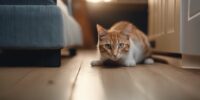How to Encourage Playful Interactions Between Cats
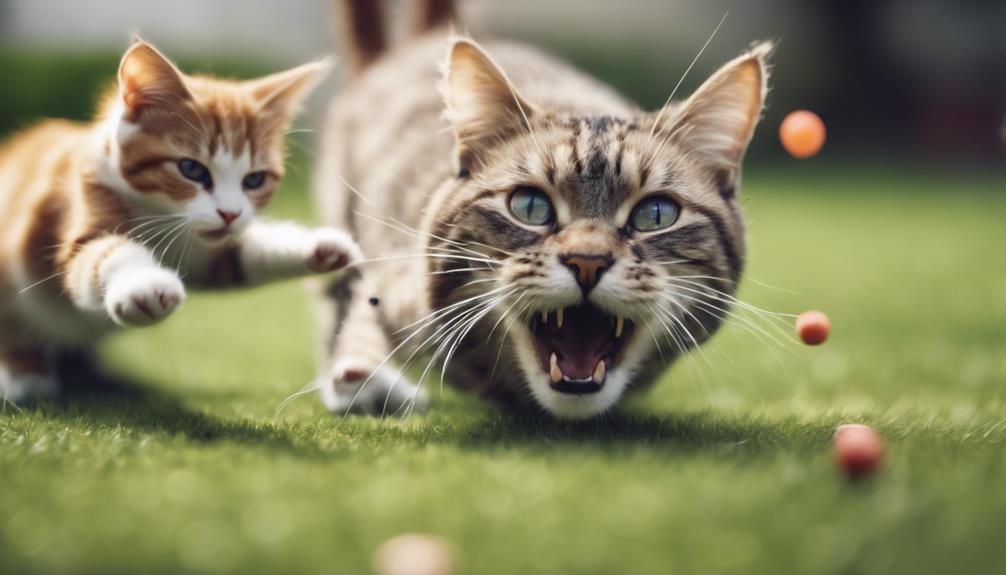
Cats are naturally playful animals and providing them with opportunities for play can help keep them mentally and physically stimulated. Here are some simple strategies to encourage playful interactions between cats:
- Provide a Variety of Toys: Cats have different preferences when it comes to toys, so offering a variety of options such as feather wands, balls, and interactive toys can keep them engaged.
- Create Play Spaces: Designate areas in your home where your cats can play freely. Cat trees, scratching posts, and tunnels are great additions to create an engaging environment for play.
- Play with Your Cats: Spend time each day engaging in interactive play with your cats. Use toys to mimic prey-like movements to stimulate their natural hunting instincts.
- Rotate Toys: To keep playtime interesting, rotate your cat's toys regularly. This can prevent boredom and encourage your cats to stay active.
- Use Treats for Play: Incorporating treats into playtime can make it more exciting for your cats. You can hide treats in puzzle toys or use them as rewards during play sessions.
By implementing these strategies, you can promote playful behaviors in your cats and strengthen the bond you share with them. Remember to observe your cats' preferences and adjust your playtime activities accordingly to keep them happy and entertained.
Understanding Your Cat's Play Preferences
Understanding your cat's play preferences can provide valuable insights into their behavior and enhance your bond with them. Cats exhibit playful body language when they're in the mood for play, such as crouching down with their hind end up, making chirping sounds, or even gently nibbling. Recognizing these cues can help you engage with your cat more effectively during playtime.
Establishing consistent playtime schedules is crucial for meeting your cat's needs. Cats are creatures of habit and thrive on routine, so setting aside dedicated time each day for play can keep them stimulated and satisfied. It also helps prevent behavioral issues that may arise from boredom or lack of mental stimulation.
Providing a Variety of Toys

Cats have varying preferences when it comes to toys, so understanding what types of toys your cat enjoys is crucial.
It's recommended to rotate toys regularly to keep your cat engaged and prevent boredom.
Engaging in interactive play sessions with your cat using a variety of toys can help strengthen your bond and provide mental and physical stimulation.
Toy Preferences Understanding
Providing a variety of toys enhances the playful interactions between cats and encourages them to engage in a range of stimulating activities. Understanding a cat's toy preferences can lead to more effective play sessions. Some cats may prefer interactive toys that mimic prey, while others might enjoy batting around balls or chasing feather wands. By observing a cat's play cues, such as dilated pupils or crouching stance, one can tailor the play experience to their liking. Below is a table summarizing common cat toy preferences:
| Toy Type | Description |
|---|---|
| Interactive | Toys that mimic prey |
| Balls | Toys for batting around |
| Feather Wands | Toys for chasing |
Rotate Toys Regularly
To enhance a cat's play experience and stimulate their engagement, regularly rotating toys is essential. Cats can quickly lose interest in toys if they're left out constantly.
By rotating toys, cat owners can keep their feline friends engaged and excited during playtime. It's recommended to have a designated toy storage area where toys can be kept when not in use. This practice helps maintain the novelty of the toys and prevents them from becoming boring to the cat.
Additionally, incorporating a playtime schedule with specific toy rotations can add structure to the cat's day and ensure they have a variety of toys to interact with. By implementing these simple strategies, cat owners can provide a stimulating and enriching play environment for their beloved pets.
Interactive Play Sessions
For optimal engagement during playtime, it's beneficial to offer a variety of interactive toys to stimulate your feline companion's interest and activity levels. Understanding cat behavior is crucial when selecting toys. Cats are natural hunters, so toys that mimic prey, like feather wands or laser pointers, can trigger their instinct to chase and pounce. Rotating different toys keeps play sessions exciting and prevents boredom.
Play techniques such as hiding toys around the house or using puzzle feeders can engage your cat mentally and physically. Interactive toys that encourage exercise, like crinkle balls or catnip mice, can help maintain your cat's health and weight. By providing a diverse range of toys, you can create dynamic and enriching play sessions that strengthen your bond with your furry friend.
Setting Up Interactive Play Sessions

Setting up interactive play sessions with your cat can enhance their physical and mental well-being while strengthening the bond between you both. To initiate these sessions, select toys that encourage interactive engagement, such as feather wands, laser pointers, or crinkly balls. Choose toys that mimic prey movements to tap into your cat's natural hunting instincts, promoting playful bonding experiences.
Create a dedicated play area free from distractions where you and your cat can focus on the interaction. Start the session by slowly moving the toy in a way that imitates prey, allowing your cat to stalk, pounce, and engage in a playful manner. Maintain a balance between letting your cat successfully 'catch' the toy and keeping the game exciting by varying your movements.
Remember to end each play session positively, perhaps with a small treat or affectionate praise. By consistently setting up interactive play sessions, you can provide mental stimulation, physical exercise, and quality bonding time for both you and your feline companion.
Incorporating Play Into Daily Routine
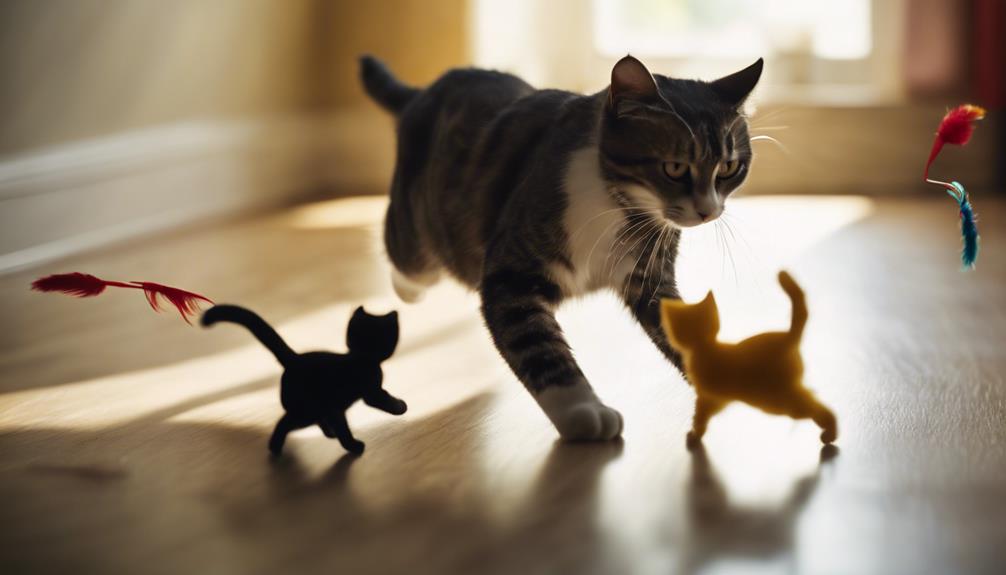
How can incorporating play into a cat's daily routine benefit their overall well-being and strengthen the bond with their owner?
Playtime scheduling is crucial for a cat's health, as it provides physical exercise, mental stimulation, and an outlet for natural hunting instincts. Interactive engagement during play sessions not only keeps the cat physically active but also fosters emotional connections with their owners. Integrating play into the daily routine helps prevent boredom, anxiety, and behavioral issues in cats, promoting a harmonious environment.
To ensure effective daily routine integration, owners can plan short play sessions at regular intervals throughout the day. Creative playtime ideas like using interactive toys, laser pointers, or puzzle feeders can make play sessions engaging and mentally stimulating for the cat. Rotating toys and introducing new ones periodically can prevent boredom and keep the cat interested in playtime. Additionally, incorporating play into activities like clicker training or hide-and-seek can further enhance the bond between the cat and its owner. By making play a consistent part of the daily routine, owners can promote a happy, healthy, and well-adjusted feline companion.
Creating DIY Cat Enrichment Activities

Creating DIY cat enrichment activities involves designing stimulating and engaging play opportunities for feline companions to enhance their overall well-being.
One homemade puzzle idea is to hide treats inside a cardboard box with holes, encouraging cats to use their natural hunting instincts to retrieve the rewards.
Another enriching activity is creating an interactive maze using everyday items like cardboard tubes or boxes, where cats can explore and navigate through different pathways to find hidden treasures.
These DIY projects not only provide mental stimulation but also promote physical activity, helping cats to stay active and curious.
When crafting these enrichment activities, it's essential to ensure they're safe, using non-toxic materials and supervising the playtime to prevent any accidents.
Using Treats to Encourage Play
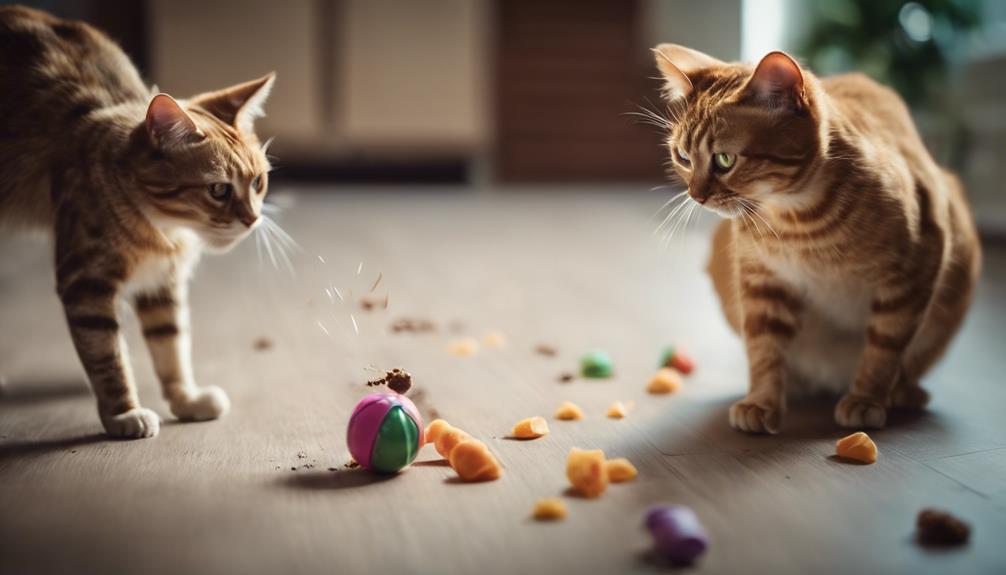
Encouraging cats to engage in playful interactions can be effectively achieved by using treats as incentives during playtime. Treat motivation can be a powerful tool to encourage cats to participate in play activities that provide mental and physical stimulation.
Here are some tips for using treats to enhance playtime with your feline companion:
- Use high-value treats: Opt for treats that your cat finds irresistible to increase their motivation to engage in play.
- Reward interactive play: Give treats as playful rewards during and after interactive play sessions to reinforce positive behaviors.
- Incorporate treat-dispensing toys: Utilize toys that dispense treats as cats play, making the experience more engaging and rewarding.
- Gradually decrease treat frequency: Over time, reduce the frequency of treats during play to encourage independent play behavior.
- Monitor treat intake: Be mindful of the number of treats given to avoid overfeeding and maintain a balanced diet for your cat.
Recognizing Signs of Overstimulation
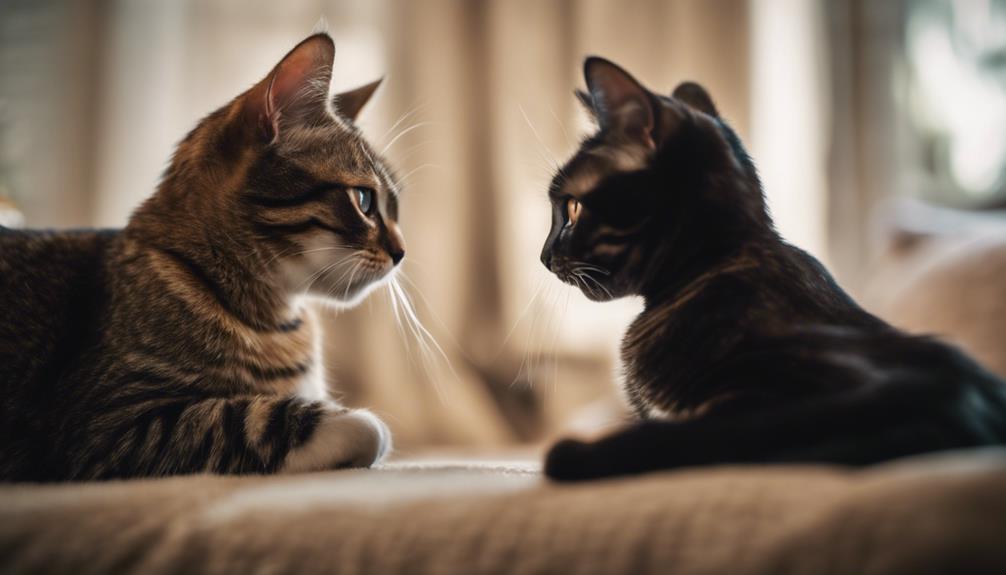
Recognizing signs of overstimulation in cats is crucial for maintaining their well-being during playtime. Cats communicate their discomfort through body language cues such as flattened ears, dilated pupils, twitching tails, and aggressive behaviors like hissing or swatting. It's essential to pay close attention to these signals to prevent escalation and ensure a positive play experience for both the cat and the owner.
Managing playtime boundaries is a key aspect of preventing overstimulation. Setting limits on the duration and intensity of play sessions can help prevent cats from becoming overwhelmed. It's important to watch for signs of fatigue or frustration and give the cat breaks as needed. Rotating toys and incorporating interactive play sessions can also help keep the cat engaged without pushing them past their limits.
Frequently Asked Questions
Can Cats Become Bored With Certain Toys Over Time, and if So, How Can I Keep Their Interest in Playtime?
Cats can indeed become bored with certain toys over time. To keep their interest in playtime, try toy rotation and playtime structure. Introduce novelty toys and enrichment puzzles to provide mental stimulation and keep them engaged.
Are There Specific Types of Toys That Are Better for Indoor Cats Versus Outdoor Cats?
When choosing toys for cats, consider indoor vs. outdoor needs. Indoor toys focus on mental stimulation, while outdoor toys cater to natural hunting instincts. Rotate toys regularly to maintain interest and engagement, ensuring a dynamic play environment for feline companions.
How Often Should Interactive Play Sessions Be Conducted to Ensure My Cat Stays Engaged and Healthy?
To maintain a cat's engagement and health, interactive play sessions should be conducted multiple times a day. These sessions provide essential mental stimulation, promote feline exercise, and create bonding opportunities between cats and their caregivers.
Are There Any Specific DIY Cat Enrichment Activities That Are Recommended for Senior Cats or Cats With Mobility Issues?
For senior cats with mobility challenges, providing DIY enrichment activities is crucial. Simple ideas like puzzle feeders, cozy hiding spots, and gentle interactive toys can stimulate their minds and bodies, promoting overall well-being and happiness.
What Are Some Signs That My Cat May Be Overstimulated During Playtime, and How Can I Prevent This From Happening?
Recognizing boundaries is crucial in cat play. Signs of overstimulation include dilated pupils, aggressive behavior, or excessive vocalization. Building trust through gradual play sessions and managing energy levels can prevent overstimulation. Ensuring safety is key.




